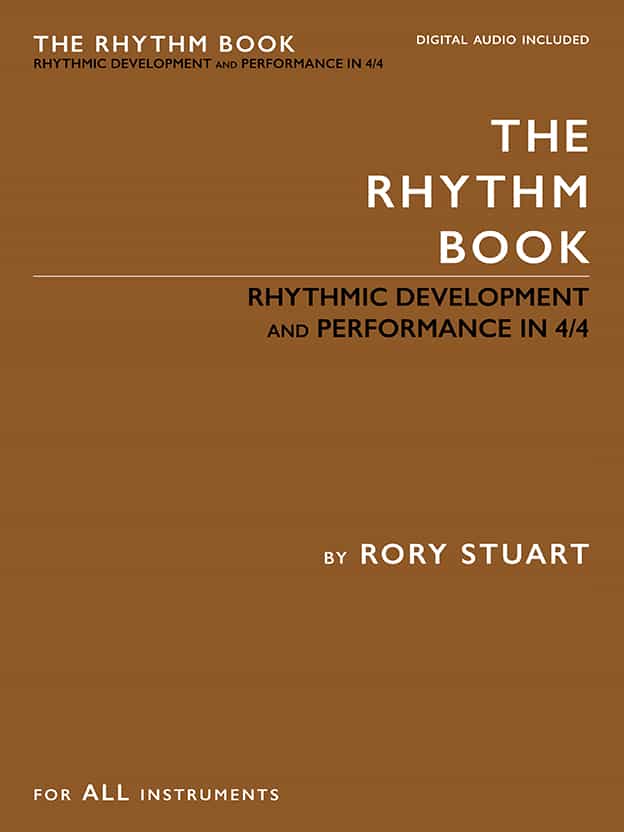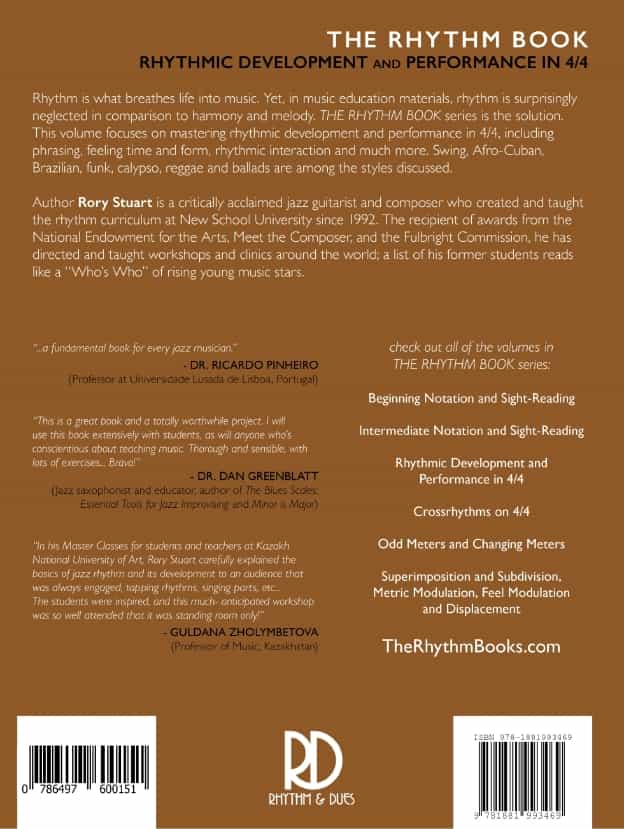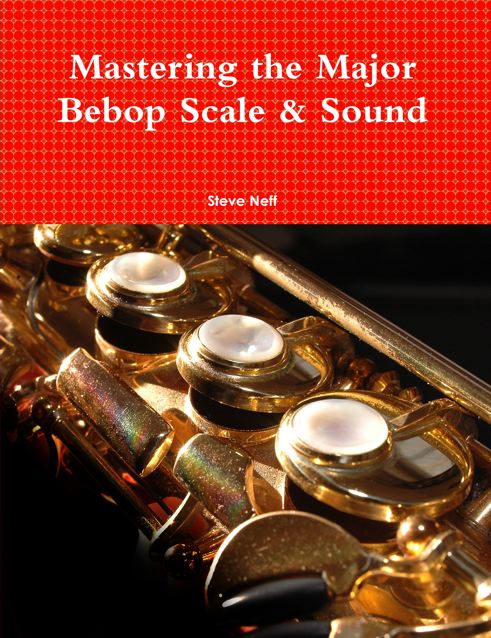Today, I am reviewing “The Rhythm Book-Rhythmic Development and Performance in 4/4” by Rory Stuart that is published by Rhythm & Dues. Rory Stuart has written a great beginning book for those of you who want to understand rhythm and notation in a deeper way that I reviewed as well as an intermediate book of more advanced concepts that I also have reviewed. Today I will be writing about The Rhythm Book-Rhythmic Development and Performance in 4/4. I just spent the last couple hours working through the book and am very impressed.
THE RHYTHM BOOK – Rhythmic Development and Performance in 4/4
Rory Stuart’s Rhythm Book website has this page about who the book would be good for which I thought would be great to include here also: (There is also an extensive preview of the book here that you can check out)
THE RHYTHM BOOK – Rhythmic Development and Performance in 4/4
This book is for you if:
• You have completed THE RHYTHM BOOK—Beginning Notation and Sight-Reading and THE RHYTHM BOOK— Intermediate Notation and Sight-Reading; or you have enough command of rhythmic notation that it is not an obstacle.
• You want to learn rhythmic concepts and practices and how to apply them in performance.
• You are any age, an adult or young learner.
• You are a vocalist, or play any instrument (including horns, piano, guitar, bass, strings — NOT just drums and percussion instruments!). This book, and the following ones in the series, are unusual in showing how rhythmic ideas connect to harmony and song form.
• You are taking music classes, studying with a private instructor, or are teaching yourself.
• You are a music teacher, who wants to teach rhythmic ideas to your students.
• You compose or would like to compose music, or write arrangements for others, and would like to incorporate rhythmic development, and greater awareness of rhythmic styles and interaction in 4/4.
• You play or want to play any style of music. This book has somewhat of an orientation towards jazz and contemporary music (funk, pop, rock, hip-hop, Afro-Cuban, Brazilian, modern classical) and includes the syncopation found in these styles of music and the swing feel of jazz. If you are an aspiring musician in a different style (e.g. folk, singer-songwriter, pre-20th century classical), you can learn what you need to know about rhythm, but the book includes some “extra” rhythmic things not usually found in your style of music.
Please note: once you have completed this book, you will be ready for the next book in THE RHYTHM BOOK series: THE RHYTHM BOOK—Crossrhythms on 4/4. From there, you can proceed to two other books in the series: THE RHYTHM BOOK—Odd Meters and Changing Meters; and THE RHYTHM BOOK—Superimposition and Subdivision, Metric Modulation, Feel Modulation and Displacement.
The Rhythm Book Series by Rory Stuart
Although this book is advertised as a follow up to “The Rhythm Book-Intermediate Notation and Sight-Reading, I would say it is a much more conceptual book than the prior books. Rhythmic Development and Performance in 4/4 takes a step back as Rory writes in depth on how to apply many of the rhythmic ideas learned in book 1 & 2 to different styles of music such as Swing and Brazillian grooves such as Sambas and Bossa Novas. The book also provides rhythmic examples over a host of other styles of music that I am unschooled in. Baiao, Frevo, Maracatu, Partido Alto, Capoeira, Calypso, as well as many others.
The book comes with 67 audio samples of the exercises in the book that are invaluable and essential to a student studying this material in my opinion. There are many more written examples in the book that don’t have audio files and many of them look difficult rhythmically. I will say that I think it would be amazing to hear audio files of these examples as well. All of these audio samples and worksheets are available on the roryrhythmbooks.com website for download after you purchase the book.
The Rhythm Book-Rhythmic Development and Performance in 4/4 starts out with discussing a jazz “swing” feel. The importance of 2 & 4 is stressed as well as the art of accenting and ghost notes are discussed. Rory provides audio samples of jazz lines with accents on the downbeats, off beats and a mix of both that I found revealing to listen to as well.
After the Swing section Rory delves into some Brazilian style rhythms. I love this quote from the beginning of this section of the book:
“I seldom run across a jazz musician who, when a commonly played Antonio Carlos Jobim tune is called, replies “No, let’s not play that, I can’t play Brazilian music.” Yet, what many jazz musicians play, when they try to play a Brazilian piece, sounds like a sort of anemic wedding band-ish thing that has only the most superficial resemblance to real Brazilian music.”
Haha! That quote above about sums it up! I used to play many of those Jobim standards after college and I honestly just played them as if I was playing jazz. Never really listened to authentic Brazilian music before that! I apologize to the Brazilian culture!
After the section of the book on different styles, there is a section on Funk that is pretty cool. Rory gives many examples such as the bass line to James Brown’s Cold Sweat, Stevie Wonder’s “For Once in My Life”, and tunes such as “Oakland Stroke” and “Squib Cakes” as well as many others as he talks about the rhythmic elements of funk music.
THE RHYTHM BOOK – Rhythmic Development and Performance in 4/4
After the Funk section, Rory writes on the topic of ballads. He touches a little bit on the ballad playing styles of Ben Webster, Billie Holiday, Wes Montgomery, John Coltrane, Bill Evans, Jim Hall, Miles Davis, etc…… These are largely conceptual descriptions of their style and playing but Rory does include some written out music and phrases throughout.
Much of the book after these sections is focused on practice suggestion and tips. Rory has included sections on:
- Feeling Time and Form
- Defining the Time in your Playing
- Fast and Slow Tempos
- Tips on Performing and Syncing Your Time with Others
- Rhythmic Interaction in a Band Setting
- Developing Rhythmic Ideas
All of these sections come with lots of tips, advice and practice suggestions. I found the “Defining Your Time” section interesting in that Rory writes about working with his combo groups on taking unaccompanied solos for the first chorus of a solo as a way to test a students time and feel. He also has an interesting exercise called “Hide the Metronome” which I have never done with a student but sounds interesting in developing an internal sense of the time for the student.
THE RHYTHM BOOK – Rhythmic Development and Performance in 4/4
Great job by Rory Stuart and Rhythm & Dues in creating “The Rhythm Book-Rhythmic Development and Performance in 4/4”. It does cover many rhythmic and stylistic principles so that the student has a firm foundation on which to build further rhythmic studies. The addition of the exercise clips on the website are a huge bonus that makes this book so much more useful although it would be great if Rory could provide audio clips of all the examples in the book as well.
On a personal note, I wish I had a book like this to work out of back in my college days. I remember the topics of “swing” and “accented notes” being a mystery to me back then that I had to basically figure out on my own. A book like this would have helped me decipher some of what I was hearing and help me figure out how to perform it so much faster.
If you end up getting the The Rhythm Book-Rhythmic Development and Performance in 4/4 by Rory Stuart please feel free to come back and share your thoughts and comments with all of us below. Thanks to Rory Stuart for writing such an in-depth and complete study on rhythm. Looking forward to the next book in the series to be released……….






Thank you for this review. You really made my day with the comments about the difficulty some people have had trying to play Brazilian music. I have struggled to get the beat of Jobim pieces and even took some drum lessons ; the drum teacher had no problem with it except me. It sounds like this book could be helpful.
Walter, My only reservation is that so much of that section of the book are examples and not exercises. There are audio clips for the exercises but not for the examples. I mention this in the review but especially for those styles of music I am not fluent in, an audio sample would be so helpful! Steve
Steve, thank you for this reminder. Maybe the author will add additional audio clips as you have suggested.
I’m working my way through the 4th book now on Crossrhythms on 4/4 which I really love. It is mostly Exercises with audio tracks. I’m really digging this one a ton! Working on a review………
Rory is a great teacher; I had the pleasure of working with him for a few years in the early aughts. He has been a great resource at New School now for decades.
Thanks Steve for review this books. I might not have come across them this quick. I got the whole series last week from Amazon. I have learnt from ‘Rhythm Coach’ by Richard Filz (64 pages with 5-8 pages of irrelevant pictures) in the past.
I thought, if an author publishes a series of 6 books on the same topic in just over 1 year, he already has the resources before putting pen to paper. ‘The Rhythm Book’ series by Rory Stuart is very comprehensive on this topic, easy to read/learn from and filled with many exercises on almost every page to drive the lesson home in little bits immediately .
Thanks Rory Stuart for sharing this curriculum with others like me, who are not privileged to attend jazz college or learn directly from you.
That’s great to hear Paul. I’m working through the “Crossrhythms on 4/4” book right now for the next review. It’s really great with so many rhythmic patterns to practice against 4/4. Steve